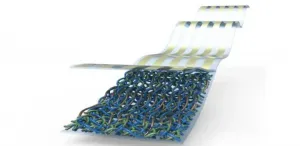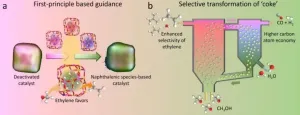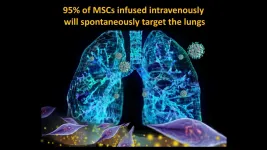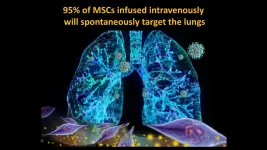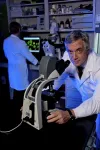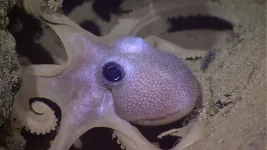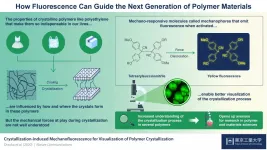Neither liquid nor solid
2021-01-05
(Press-News.org) While glass is a truly ubiquitous material that we use on a daily basis, it also represents a major scientific conundrum. Contrary to what one might expect, the true nature of glass remains something of a mystery, with scientific inquiry into its chemical and physical properties still underway. In chemistry and physics, the term glass itself is a mutable concept: It includes the substance we know as window glass, but it may also refer to a range of other materials with properties that can be explained by reference to glass-like behaviour, including, for instance, metals, plastics, proteins, and even biological cells.
While it may give the impression, glass is anything but conventionally solid. Typically, when a material transitions from a liquid to a solid state the molecules line up to form a crystal pattern. In glass, this does not happen. Instead, the molecules are effectively frozen in place before crystallization happens. This strange and disordered state is characteristic of glasses across different systems and scientists are still trying to understand how exactly this metastable state forms.
A novel state of matter: liquid glass
Research led by professors Andreas Zumbusch (Department of Chemistry) and Matthias Fuchs (Department of Physics), both based at the University of Konstanz, has just added another layer of complexity to the glass conundrum. Using a model system involving suspensions of tailor-made ellipsoidal colloids, the researchers uncovered a new state of matter, liquid glass, where individual particles are able to move yet unable to rotate - complex behaviour that has not previously been observed in bulk glasses. The results are published in the Proceedings of the National Academy of Sciences of the United States of America (PNAS) (date of publication: 19 January 2021; published online: 4 January 2021).
Colloidal suspensions are mixtures or fluids that contain solid particles which, at sizes of a micrometre (one millionth of a metre) or more, are bigger than atoms or molecules and therefore well-suited to investigation with optical microscopy. They are popular among scientists studying glass transitions because they feature many of the phenomena that also occur in other glass-forming materials.
Tailor-made ellipsoidal colloids
To date, most experiments involving colloidal suspensions have relied on spherical colloids. The majority of natural and technical systems, however, are composed of non-spherical particles. Using polymer chemistry, the team led by Andreas Zumbusch manufactured small plastic particles, stretching and cooling them until they achieved their ellipsoid forms and then placed them in a suitable solvent. "Due to their distinct shapes our particles have orientation - as opposed to spherical particles - which gives rise to entirely new and previously unstudied kinds of complex behaviours", explains Zumbusch, who is a professor of physical chemistry and senior author on the study.
The researchers then went on to change particle concentrations in the suspensions, and tracked both the translational and rotational motion of the particles using confocal microscopy. Continues Zumbusch: "At certain particle densities orientational motion froze whereas translational motion persisted, resulting in glassy states where the particles clustered to form local structures with similar orientation". What the researchers have termed liquid glass is a result of these clusters mutually obstructing each other and mediating characteristic long-range spatial correlations. These prevent the formation of a liquid crystal which would be the globally ordered state of matter expected from thermodynamics.
Two competing glass transitions
What the researchers observed were in fact two competing glass transitions - a regular phase transformation and a nonequilibrium phase transformation - interacting with each other. "This is incredibly interesting from a theoretical vantage point", comments Matthias Fuchs, professor of soft condensed matter theory at the University of Konstanz and the other senior author on the paper. "Our experiments provide the kind of evidence for the interplay between critical fluctuations and glassy arrest that the scientific community has been after for quite some time". A prediction of liquid glass had remained a theoretical conjecture for twenty years.
The results further suggest that similar dynamics may be at work in other glass-forming systems and may thus help to shed light on the behaviour of complex systems and molecules ranging from the very small (biological) to the very big (cosmological). It also potentially impacts the development of liquid crystalline devices.
INFORMATION:
The research was initiated as part of the University of Konstanz's Collaborative Research Centre (CRC) 1214 "Anisotropic Particles as Building Blocks: Tailoring Shape, Interactions and Structures", which was funded by the German Research Foundation (DFG) from 2016 to 2020.
Facts:
A team of chemists and physicists from the University of Konstanz has discovered a new state of matter, liquid glass, with previously unknown structural elements.
Research led by Professor Andreas Zumbusch (Department of Chemistry) and Professor Matthias Fuchs (Department of Physics) provides new insights into the as-yet unresolved issue of glass transition.
Experiments with ellipsoidal colloids reveal that liquid glass forms because the particles are able to move but unable to rotate - which results in local particle clusters that obstruct each other and thus prevent an ordered state of matter from forming.
Original publication: Jörg Roller, Aleena Laganapan, Janne-Mieke Meijer, Matthias Fuchs, Andreas Zumbusch: Observation of liquid glass in suspensions of ellipsoidal colloids, PNAS, 4 January 2021. URL: https://doi.org/10.1073/pnas.2018072118
The research was initiated as part of the University of Konstanz's Collaborative Research Centre (CRC) 1214 "Anisotropic Particles as Building Blocks: Tailoring Shape, Interactions and Structures", which was funded by the German Research Foundation (DFG) from 2016 to 2020.
Note to editors:
You can download a photo here: https://cms.uni-konstanz.de/fileadmin/pi/fileserver/2020/Bilder/Weder_fluessig_noch_fest.png
Caption: Image of the position and orientation of ellipsoidal particles in clusters of a liquid glass.
Image credit: Research groups of Professor Andreas Zumbusch and Professor Matthias Fuchs
Contact:
University of Konstanz
Communications and Marketing
Phone: +49 7531 88-3603
Email: kum@uni-konstanz.de
- uni.kn/en
[Attachments] See images for this press release:
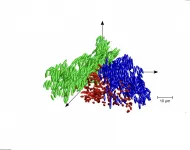
ELSE PRESS RELEASES FROM THIS DATE:
2021-01-05
Sunlight offers a potential solution in the search for an energy source that does not harm the planet, but this depends on finding a way to efficiently turn electromagnetic energy into electricity. Researchers from KAUST have shown how a known herbicide can improve this conversion in organic devices.
While solar cells have traditionally been made from inorganic materials such as silicon, organic materials are starting to break through as an alternative because they are light, flexible and relatively inexpensive to make, even offering the possibility for ...
2021-01-05
MTO process, which was first commercialized in 2010, is a catalytic process converting methanol, which is typically made from coal, natural gas, biomass, and CO2, over SAPO-34 zeolite catalyst. It's becoming one of the main streams for producing light olefins, including ethylene and propylene, from non-oil resources.
One of the major challenges in MTO is the rapid deactivation of zeolite catalyst due to the coke deposition.
In industrial practices, a fluidized bed reactor-regenerator configuration is normally used in order to maintain the continuous operation, in ...
2021-01-05
Dr. Camilo Ricordi, director of the Diabetes Research Institute (DRI) and Cell Transplant Center at the University of Miami Miller School of Medicine, and his team of international collaborators are reporting the results of a groundbreaking randomized controlled trial showing umbilical cord-derived mesenchymal stem cell (UC-MSC) infusions safely reduce risk of death and quicken time to recovery for the most severe COVID-19 patients. Dr. Ricordi's peer-reviewed paper has just been published in STEM CELLS Translational Medicine (SCTM) January 2021.
The clinical trial, authorized by the FDA last ...
2021-01-05
Dr. Camilo Ricordi, director of the Diabetes Research Institute (DRI) and Cell Transplant Center at the University of Miami Miller School of Medicine, and his team of international collaborators are reporting the results of a groundbreaking randomized controlled trial showing umbilical cord-derived mesenchymal stem cell (UC-MSC) infusions safely reduce risk of death and quicken time to recovery for the most severe COVID-19 patients. Dr. Ricordi's peer-reviewed paper has just been published in STEM CELLS Translational Medicine (SCTM) January 2021.
The clinical trial, authorized by the FDA last April, was initiated by The Cure Alliance, a 501(c)(3) non-profit organization of research scientists founded ten years ago by Dr. Ricordi for scientists ...
2021-01-05
Like any other plant, Arabidopsis thaliana or mouse-ear cress, needs nitrogen to survive and thrive. But, like maize, beans and sugar beet, it prefers nitrogen in the form of nitrate, growing better on nitrate rich soil. Whereas, pine and rice for example preferentially grow on ammonium nutrition, another form of the key macronutrient nitrogen. If the concentration or the availability of the different forms of nitrogen fluctuate, plants have to adapt quickly. "One of the most important questions is, what is the role of plant hormones in adaptation to the nitrogen availability? How do the machineries within a plant cope with their changing environment?" asks Eva Benková, developmental biologist and Professor at the Institute of Science and Technology (IST) Austria.
Finding the balance
In ...
2021-01-05
University of Miami Miller School of Medicine researchers led a unique and groundbreaking randomized controlled trial showing umbilical cord derived mesenchymal stem cell infusions safely reduce risk of death and quicken time to recovery for the severest COVID-19 patients, according to results published in STEM CELLS Translational Medicine in January 2021.
The study's senior author, Camillo Ricordi, M.D., director of the Diabetes Research Institute (DRI) and Cell Transplant Center at the University of Miami Miller School of Medicine, said treating COVID-19 with mesenchymal stem cells makes sense.
Results: treatment group vs. ...
2021-01-05
Inspired by the color-changing skin of cuttlefish, octopuses and squids, Rutgers engineers have created a 3D-printed smart gel that changes shape when exposed to light, becomes "artificial muscle" and may lead to new military camouflage, soft robotics and flexible displays.
The engineers also developed a 3D-printed stretchy material that can reveal colors when light changes, according to their study in the journal ACS Applied Materials & Interfaces.
Their invention is modeled after the amazing ability of cephalopods such as cuttlefish, octopuses and squids to change the color and texture of their soft skin for camouflage and communication. This is achieved by the ...
2021-01-05
In modern times, manufacturers produce highly specialized materials for a wide array of uses, called polymers. Polymers have a variety of purposes owing to their versatile properties, ranging from being used in construction due to their high tensile strength and resistance to manufacturing plastic bags that require more lightweight, flexible materials, such as nylon or polyethene.
These differences between the properties of different polymers stems from their internal structure. Polymers are made up of long chains of smaller sub-units, called "monomers." Crystallization occurs when crystalline polymers are melted, then cooled down slowly, which enables the chains to organize themselves into neatly arranged ...
2021-01-05
Grasslands are managed worldwide to support livestock production, while remaining natural or semi-natural ones provide critical services that contribute to the wellbeing of both people and the planet. Human activities are however causing grasslands to become a source of greenhouse gas emissions rather than a carbon sink. A new study uncovered how grasslands used by humans have changed our climate over the last centuries.
Grasslands are the most extensive terrestrial biome on Earth and are critically important for animal forage, biodiversity, and ecosystem services. They absorb and release carbon dioxide (CO2), and emit methane (CH4) from grazing livestock and nitrous oxide (N2O) from soils, especially when manure or ...
2021-01-05
A new study out of the University of Chicago Medicine following young adult drinkers for 10 years has found that individuals who reported the highest sensitivity to alcohol's pleasurable and rewarding effects at the start of the trial were more likely to develop an alcohol use disorder (AUD) over the course of the study.
Moreover, when retested on their responses 10 years later, those who became alcoholics had the highest levels of alcohol stimulation, liking and wanting - and these were heightened compared to their baseline with no signs of tolerance to these pleasurable effects.
The research, published on Jan. 5 in the American Journal of Psychiatry, followed a ...
LAST 30 PRESS RELEASES:
[Press-News.org] Neither liquid nor solid

